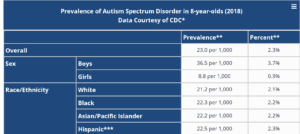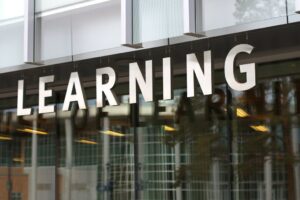Chapter 9: Neurodevelopmental Disorders
Overview
This chapter is based on the restructuring of the DSM-V. Throughout the iterations of the DSM, some shifts have occurred to bring these disorders together into this culminating category. This is a very broad category with more information provided in the DSM, including disorders not covered here. This chapter focuses on the most common disorders.
Attention-Deficit/Hyperactivity Disorder (ADHD)
Criteria to Diagnose: ADHD is a persistent patter of behavior that includes a lack of attention potentially paired with energetic impulsivity. These components are severe enough to interfere with normal functioning or the development of an individual. The most common types of symptoms are , , and (NIMH, 2022). These symptoms must last for at least six months and must impair normal functioning; symptoms usually appear before an individual turns seven years of age and occur in multiple settings (American Psychological Association, 2022).
Typical Demographics: The American Psyciatric Association (2022) estimates that roughly 8.4% of children and 2.5%of adults have ADHD. This disorder is often identified at an early age and is generally more prevalent in boys than girls.
Treatment, Medications, and Therapies: Medication is a common treatment for those with ADHD, including stimulants and some antidepressants. Pscyhotherapy and psychosocial interventions are beneficial for individuals and their families in order to manage symptoms and also to improve general functioning (NIMH, 2022). This disorder often displays with other disorders as well like ODD, CD, learning disorders, anxiety, and others (Mayo Clinic, 2022).
Case Studies to Review:
- ADHD increasing among adults (2019)
- Racial Disparities in ADHD (2020)
- A case study in attention-deficit/hyperactivity disorder: An innovative neurofeedback-based approach (2022)
- Overdiagnosis of attention-deficit/hyperactivity disorder in children and adolescents (2021)
Autism Spectrum Disorder
Autism Spectrum Disorder (ASD) affects how individuals interact, learn, and behave. It is considered developmental, according to NIMH (2022), because “the symptoms generally appear in the first two years of life”. ASD has been re-evaluated to be a spectrum rather than several different disorders because it appears that particular symptoms are pervasive over time, just varying degrees. ASD has replaced previous disorders like Asperger’s disorder, Rett’s disorder, and others (Black and Grant, 2014).
Criteria to Diagnose: There are two main categories of symptoms: social communication/interaction and restrictive/repetitive behaviors (NIMH, 2022).
- Social communication/interaction symptoms may include but are not limited to: lack of eye contact, infrequent participation in activities, lack of response to name, lack of awareness when talking, features and movements are unrelated to what is being shared, abnormal tone of voice, difficultly adjusting
- Restrictive/repetitive behaviors may include but are not limited to: repeating behaviors (including the unusual ones), intense interest in numbers and facts, must have a consistent routine in order to function, sensitive to sensory changes or experiences.
Typical Demographics:

Treatment, Medications, and Therapies: Medication will be tailored to fit the needs of the individual, depending on the presenting symptoms (NIMH, 2022). There are other interventions that can be implemented in different areas, to build skills like in education, home-life, and behavioral scenarios.
Case Studies to Review:
- Case studies of challenges in emergency care for children with Autism Spectrum Disorder (2021)
- Reflections of COVID-19 pandemic on Autism Spectrum Disorder: A descriptive case study (2021)
- A case study of parent-child interaction therapy for a young child with Autism Spectrum Disorder: Behavioral and developmental considerations (2020)
Communication Disorders
Communication disorders include situations when individuals have significant impairments in language, speech, and communication (Black and Grant, 2014). Review the slides below to learn more. Select the double pointed arrow to expand to full screen.
Intellectual Developmental Disorder
This disorder includes mild to significant limitations in functioning and adaptive behaviors (American Psychological Association, 2022). A diagnosis requires testing of intellectual capacity, social skills, and basic life skills (i.e. hygiene). Intelligence is defined as “general mental ability” (Black & Grant, 2014).
Criteria to Diagnose: Deficits in intellectual ability (examples: reasoning, problem-solving, planning, etc.) and deficits in adaptive functioning in practical and social areas. This must be significant enough to impair functioning and the onset must be during a developmental period (Black & Grant, 2014).
Typical Demographics: Roughly 1-2 percent of the population have this disorder; it is more prevalent in boys than girls.
Treatment, Medications, and Therapies: Treatment plans usually hone in on the strengths and needs of the person. Therapies and support groups can help individuals and families with this disorder.
Case Studies to Review:
- Support for people with intellectual and developmental disabilities during the COVID-19 pandemic from their own perspective (2021)
- The devastating impact of COVID-19 on individuals with intellectual disabilities in the United States (2021)
Specific Learning Disorder

Criteria to Diagnose: Individuals with this disorder demonstrate difficulties learning including reading, reading comprehension, spelling, expression, numbers, and reasoning (Black & Grant, 2014). The symptoms are significantly interfering with the person’s academic or work performance and may not “manifest” until later in life. These difficulties are not caused by another disorder or condition, but must last at least six months.
Typical Demographics: Estimates show that up to 15% of children have a learning disorder; dyslexia is the most common disorder, equally affecting males and females. These disorders often occur with other disorders like ADHD and anxiety (American Psychiatric Association).
Treatment, Medications, and Therapies: Treatment can include specialized learning opportunities and accommodations, therapy, medication, and alternative medicine. The treatment plan for an individual will evolve over time, just like the individual evolves over time.
Case Studies to Review:
- Living with learning difficulties: Two case studies exploring the relationship between emotion and performance in students with learning difficulties (2020)
- Prevalence of Specific Learning Disorders (SLD) among children in India: A systematic review and meta-analysis (2022)
- Understanding, educating, and supporting children with specific learning disabilities: 50 years of science and practice (2019)
- School failure in a girl with specific learning difficulties, suffering from childhood depression: Interdisciplinary therapeutic approach (2020)
References
American Psychiatric Association (2022). ADHD increasing among adults. Retrieved on August 26, 2022 from https://www.psychiatry.org/news-room/apa-blogs/adhd-increasing-among-adults
American Psychiatric Association (2022). Racial disparities in ADHD. Retrieved on August 26, 2022 from https://www.psychiatry.org/news-room/apa-blogs/racial-disparities-in-adhd
American Psychological Association (2022). Attention-deficit/hyperactivity disorder. APA. Retrieved on August 26, 2022 from https://dictionary.apa.org/attention-deficithyperactivity-disorder
American Speech-Language-Hearing Association (2015). Almost 8 percent of U.S. children have a communication or swallowing disorder. ASHA Wire. Retrieved on August 25, 2022 from https://leader.pubs.asha.org/doi/10.1044/leader.NIB1.20082015.10
Black, D. W., & Grant, J. E. (2014). DSM-5® Guidebook : The Essential Companion to the Diagnostic and Statistical Manual of Mental Disorders, Fifth Edition: Vol. Fifth edition. American Psychiatric Association Publishing.
Bozkurt, S., Bozkus, G., Yildix, G. (2021). Reflections of COVID-19 pandemic on Autism Spectrum Disorder: A descriptive case study. Journal of Qualitative Research in Education 9(1). http://DOI:10.14689/enad.25.2
Cabaleiro P, Cueli M, Cañamero LM, González-Castro P. A Case Study in Attention-Deficit/Hyperactivity Disorder: An Innovative Neurofeedback-Based Approach. Int J Environ Res Public Health. 2021 Dec 24;19(1):191. doi: 10.3390/ijerph19010191.
Children’s Hospital of Philadelphia (2022). Communication disorders. Retrieved on August 25, 2022 from https://www.chop.edu/conditions-diseases/communication-disorders
Gleason, J., Ross, W., Fossi, A., Blonsky, H., Tobias, J., Stephens, M. (2021). The devastating impact of COVID-19 on individuals with intellectual disabilities in the United States. Innovations in Care Delivery. https://catalyst.nejm.org/doi/full/10.1056/CAT.21.0051
Gray, J. M., & Roback, M. G. (2021). Case Studies of Challenges in Emergency Care for Children With Autism Spectrum Disorder. Pediatric emergency care, 37(12), e1756–e1758. https://doi.org/10.1097/PEC.0000000000002074
Johnson & Johnson (2009). Brad’s story: A 12-year old with ADHD [Video]. YouTube. https://www.youtube.com/watch?v=z2hLa5kDRCA
Kazda, L. Bell, K., Thomas, R. (2021). Overdiagnosis of attention-deficit/hyperactivity disorder in children and adolescents. JAMA Network Open 4(4).
Lisi, E. (2020, April 29). What it’s really like to have autism [Video]. YouTube. https://www.youtube.com/watch?v=y4vurv9usYA
Mayo Clinic (2022). ADHD symptoms and causes. Retrieved on August 25, 2022 from https://www.mayoclinic.org/diseases-conditions/adhd/symptoms-causes/syc-20350889
Mayo Clinic (2022). Learning disorders. Children’s Health. Retrieved on August 25, 2022 from https://www.mayoclinic.org/healthy-lifestyle/childrens-health/in-depth/learning-disorders/art-20046105
McGovern Institute (2014, June 30). Inside the adult ADHD brain [Video]. YouTube. https://www.youtube.com/watch?v=rp1IleFD4D0
Medical News Today (2020). What to know about intellectual disability. Retrieved on August 25, 2022 from https://www.medicalnewstoday.com/articles/intellectual-disability
National Institute of Mental Health (2022). Attention-deficit/hyperactivity disorder. Health Topics. Retrieved on August 26, 2022 from https://www.nimh.nih.gov/health/topics/attention-deficit-hyperactivity-disorder-adhd
National Institute of Mental Health (2022). Autism spectrum disorder. Health Topics. Retrieved on August 26, 2022 from https://www.nimh.nih.gov/health/topics/autism-spectrum-disorders-asd
National Institute of Mental Health (2022). Autism spectrum disorder. Mental Health Information. Retrieved on August 26, 2022 from https://www.nimh.nih.gov/health/statistics/autism-spectrum-disorder-asd
Navas, P., Amor, A. M., Crespo, M., Wolowiec, Z., & Verdugo, M. Á. (2021). Supports for people with intellectual and developmental disabilities during the COVID-19 pandemic from their own perspective. Research in developmental disabilities, 108, 103813. https://doi.org/10.1016/j.ridd.2020.103813
Papadopoulos, D. (2020). A case study of parent-child interaction therapy for a young child with Autism Spectrum Disorder: Behavioral and developmental considerations. Scientific Research. 11 (6). https://doi.org/10.4236/psych.2020.116058
Phillips, J. (2018, February 23). ADHD: Finding what works for me [Video]. YouTube. https://www.youtube.com/watch?v=Iw2QCcm0yIA
Scaria LM, Bhaskaran D, George B. Prevalence of Specific Learning Disorders (SLD) Among Children in India: A Systematic Review and Meta-Analysis. Indian Journal of Psychological Medicine. June 2022. doi:10.1177/02537176221100128
Siouli, S., Makris, S., Romanopoulou, E., Bamidis, P.P.D. (2020). Living with Learning Difficulties: Two Case Studies Exploring the Relationship Between Emotion and Performance in Students with Learning Difficulties. In: Alario-Hoyos, C., Rodríguez-Triana, M.J., Scheffel, M., Arnedillo-Sánchez, I., Dennerlein, S.M. (eds) Addressing Global Challenges and Quality Education. EC-TEL 2020. Lecture Notes in Computer Science(), vol 12315. Springer, Cham. https://doi.org/10.1007/978-3-030-57717-9_10
Tatsiopoulou, P., Porfyri, G. N., Bonti, E., & Diakogiannis, I. (2020). School Failure in a Girl with Specific Learning Difficulties, Suffering from Childhood Depression: Interdisciplinary Therapeutic Approach. Brain sciences, 10(12), 992. https://doi.org/10.3390/brainsci10120992
lack of ability to stay focused not related to defiance or lack of understanding (NIMH, 2022)
constant movement, especially in inappropriate scenarios, sometimes can include excessive talking (NIMH, 2022).
the individual will behave without thinking or lack the ability to control their actions. They may also interrupt others or not consider consequences (NIMH, 2022)

